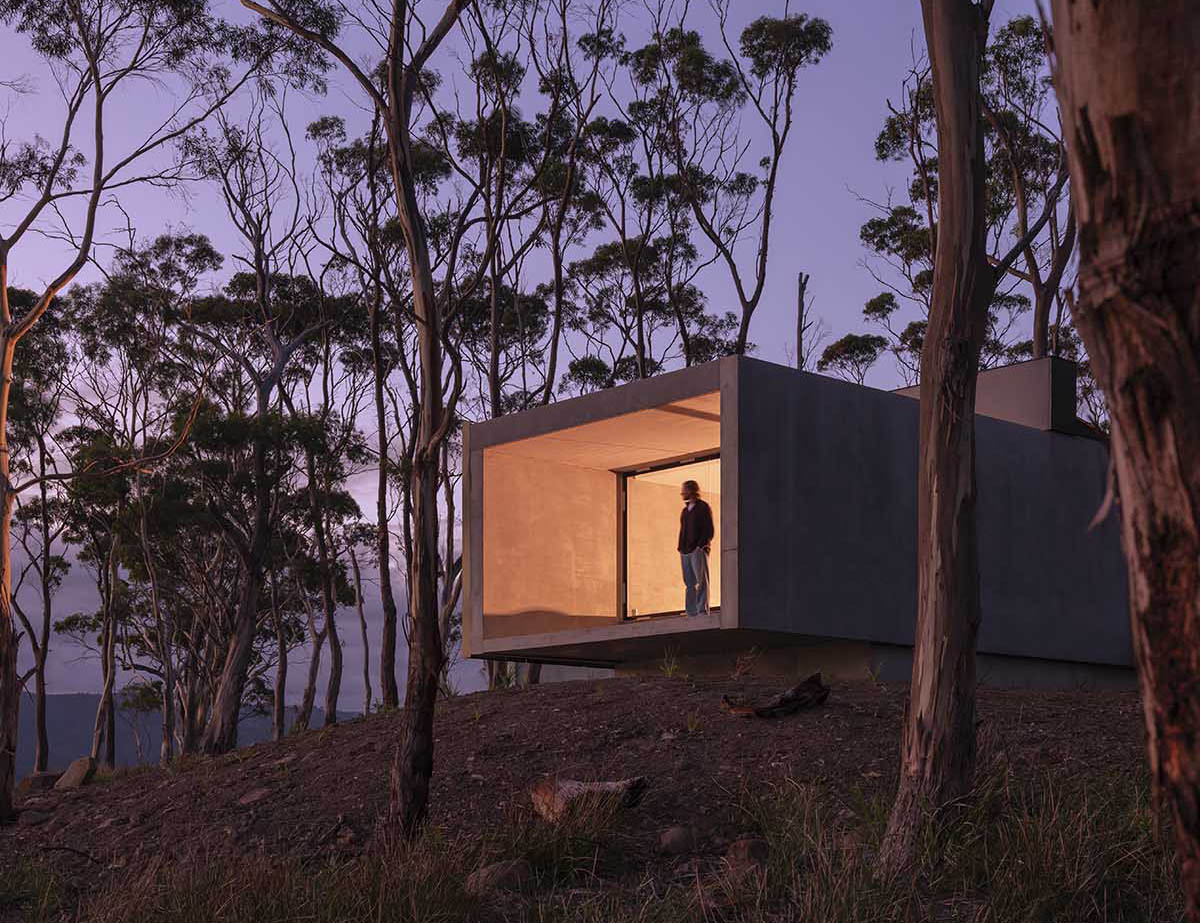worldarchitecture.org
html PUBLIC "-//W3C//DTD HTML 4.0 Transitional//EN" "http://www.w3.org/TR/REC-html40/loose.dtd"Emerging from the lush bushlands of Tasmania, a robust concrete tunnel stands as a testament to innovative, off-the-grid design, designed by Hobart-based studio Room11 architects.Designed for Danish design brand Vipp, this time, Vipp travels to the Southern Hemisphere for the brands latest guesthouse.The Vipp Tunnel is an architecturally bold and sustainably designed structure that balances beauty and brutalism. It cantilevers over a sloping hill on Tasmania's Bruny Island.This property, developed from the ground up, showcases a collection of outdoor sculptures by acclaimed Danish artist Lin Utzon. It serves as a distinctive sanctuary that combines art, design, and nature.Tasmania, often called "the edge of the world", is marked by its unique sense of being in another world. In this part of the world, immersive environments provide a grounding effect and remind us of our bond with nature.Stepping off the small ferry from Hobart to Bruny Island after a 20-minute ride is like being transported and retuned into the frequency and rhythm of nature.Guests are welcomed at the north-western tip of Bruny Island, where a couple of rare white wallabies can be seen roaming the expansive grounds, when one sets the compass to 42 S of the equator.Where the rough bushlands converge with the sea, the concrete edifice appears to defy gravity over a landscape marked by a 300-meter stretch of water offering a 280 vista of the D'Entrecasteaux Channel that links Bruny Island to Tasmanias mainland."On Bruny Island we have created understandable forms that do not mimic context, rather they create an intelligible form from which we can comprehend the nature of place," said Thomas Bailey, Architect AIA, Director Room11."It is a place where the cut of contemporary architectural thinking is starkly rendered against a raw natural context," Bailey added.Widely recognised for their residential, commercial, and hospitality work throughout Australia, Room11 has created a sculptural, brutalist structure dropped into the bushlands. Balancing on the edge between solid ground and open air, Vipp Tunnel expresses a playful dialogue between concrete cubism and its organic surroundings.A project three years in the making, the finished guesthouse embodies Room11s interest in craftsmanship and distinctive approach to architecture that is sensitive to landscape, detail, and materiality.The 30-meter-long tunnel, measuring 160 square meters, features wall-to-wall glass and recessed steel doors that offer unobstructed views of the soulful landscape of the Tasmanian sea and mountains. Windows that stretch from the floor to the ceiling and lightwells give the space a luminous quality.At the end of the corridor, a glass door opens onto a terrace that appears to float above the ground, exemplifying architectural skill and enhancing the feeling of being on the brink of the world. An atrium yard divides the primary living area from the master bedroom and bathroom."The dramatically elongated proportions of the structure respond to the landscape by purposely framing the D'Entrecasteaux Channel with a broad expanse of frameless glass. By this methodology the user is located in the extraordinary, natural landscape of Tasmania's Bruny Island," said Thomas Bailey.A distinct concrete cube measuring 35 square meters and with ceilings of 4 metres in height, known as the studio, provides an escape to a visually and sensorially tranquil environment. Its minimalist design makes it ideal for use as an office or meditation room, emphasizing the architecture and featuring only a Vipp Swivel chair, an integrated desk, and a concealed mezzanine double bed.The diverse encounter between counterparts persists in the meeting point of Vipps Danish interior minimalism and the magnificence of Australias nature.Tasmania offers the stunning exterior, while Danish design brand Vipp provides the interior. The new V3 kitchen from Vipp, constructed entirely from aluminium, is the focal point of the main area as if it were designed specifically for this project.The kitchen island, featuring a monumental stainless steel counter and fluted aluminum doors, reflects the materials used in the buildings architecture.Vipp furniture, such as Vipp Swivel chairs covered with Australian sheepskin, has been thoughtfully chosen to create an air of refined sophistication in contrast to the tunnel's bare shell. Meanwhile, a custom sunken lounge adds a touch of softness to the space."Our portfolio of guesthouses is about elevating the product experience and creating a doorway into our design universe. By working with different architectural typologies and vernacular we can craft distinct design experiences," said Kasper Egelund.Danish artist Lin Utzon has enhanced the distinctive fusion of Danish design and Australian architecture by introducing an edition of her renowned 'Cosmic Dancers' series on the shores of Bruny Island.The large-scale black-and-white ceramic sculptures, positioned among the propertys red gum trees, reflect the elongated strokes found on these characteristic trees.Lin has deep ties to Australia as the daughter of Jrn Utzon, the acclaimed architect behind the Sydney Opera House. Lin, who is now a successful artist in her own right, often reflects her fathers philosophy of harmonizing art and architecture in her work.Her Cosmic Dancers displayed in the Australian bushland next to the architectural design of Vipp Tunnel forge a powerful link to these elements of her life and work."Vipp travels south of the equator for the opening of our first guesthouse in Australia, adding to our steadily growing portfolio of Vipp guesthouses around the world. Known for its design excellence and remarkable natural surroundings, it makes for the ideal destination that has so many affinities with our Danish roots. Room11 has created a truly breathtaking piece of architecture, a space for reflection and escape, that perfectly complements Vipps design ethos," said Kasper Egelund, CEO and 3rd generation Vipp owner.Light at the end of the tunnelTaking inspiration from the region's natural wonder, the Aurora Australis (Southern Lights), which turns the nocturnal sky into a colorful dreamscape, Room11 has incorporated chromatic glazing into the main skylights of the structure.The effect is amplified by polished concrete floors and walls, which mirror the dynamic interplay of light that moves through the otherwise subtle interior like a constantly evolving work of art."The kaleidoscopic lightwell installation offers a dynamic interplay of colour and time. As the sun moves and seasons shift, vivid hues of yellow, pink, and orange are cast across the concrete interior marking the changing light at 42 south. Designed to respond to seasonal transitions, the installation ensures that no two visits are ever the same," explained the entrepreneur of the project, Dane Taylor."A visit to Vipp Tunnel is an immersion into raw nature and raw architecture. Its a station of solitude at the edge of the world."Off-grid hideawayThe building is energy-sufficient and operates off-grid, thanks to its entire west-facing faade clad in solar panels."The entire western faade is derived from the geometry of the solar array. An unequivocal statement of prioritising green energy production in contemporary construction. Its a celebration of a new frontier in sustainable construction. As far as we are aware, this is the first building to feature an entire faade created by solar technology, making the most of the location's latitude," said Thomas Bailey.The building has been ingeniously engineered to reduce the direct footprint of the construction by elevating it from the ground. Room11 performed surveys of all trees on the site and planned roadworks around important trees during the design process.A slim construction corridor was set up to ensure that the effect on endemic vegetation was reduced to an absolute minimum.The design of the concrete panel offers thermal insulation, maintaining a consistent temperature year-round and reducing reliance on heating and cooling systems. The building features heated flooring and air conditioning for optimal comfort."Material choices and construction methodologies utilised shall ensure a building of great longevity with the minimum of means. The project is a statement of quality over quantity," added Thomas Bailey.This retreat operates solely on rainwater and is powered by self-sufficient energy. With plenty of local produce available for purchase on the island, guests can genuinely live off the land.Floor planStudio floor planEast-West elevationsSouth-North elevationsSnhetta and Danish interior brand Vipp also built nest-like wooden cabins that give the sense of "the illusion of floating in the air" on the edge of Lysefjorden on the Norwegian west coast.Vipp is a company owned by the same family for three generations, and it is of Danish origin. In 1939, metalsmith Holger Nielsen established a business in the small Danish town of Randers, where he made his entrepreneurial debut with a practical waste bin designed for his wifes hair salon.Project factsProject name:Vipp Tunnel, TasmaniaLocation:Bruny Island, Tasmania, AUSArchitects:Room11Builder:Merlin ConstructionInterior: VippSize: 160 m2Area: 3 ha landCompleted:March 2025Styling:Jack MilenkovicAll images Adam Gibson, Courtesy of Vipp.All drawings Room11.> via Vipp












